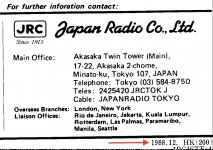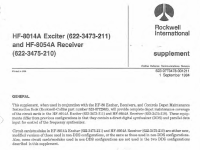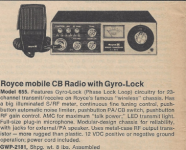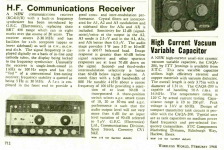13dka
Member
Finding out how and when exactly DDS came into existence seems to be harder than I expected. It looks like patents for numerically controlled oscillators (NCO) emerged in the 70s but it seems it could be questioned whether or not the technology had a direct advantage for military or commercial usage yet. The "Speakeasy" SDR concept/project if I understood that right was a 1990s thing and commercial radio research had shifted largely towards cellphone technology I guess, so many "firsts" are to be found there, probably...
Poking around in ham radio service manuals instead, first clues were radios like the 1992 -DX update to the Kenwood TS-950S, the 1993 TS-50 or the 1996 AOR AR-5000 sporting the DDS acronym in their documentation.
It looks like JRC's JST-135 transceiver of 1988 (date of manual print) is the first radio I can find, and the NRD-535 seems to have inherited the dual DDS, dual PLL board from it in 1991, so that might be your candidate for a first SWL radio with DDS? JRC apparently produced their own DDS ICs for that board, so the internet claiming "mid 90s" for the first integrated DDS chips seems questionable.

However, comparing phase noise figures in order to identify DDS radios wasn't the bright idea I thought it was -- for example, the AOR 5000 has particularly high (103dBc/Hz @10kHz spacing) phase noise on Rob Sherwood's test bench, that's right among the noisiest of PLL synthesizers (like in the R600 - R2000, FRG7700... more than a decade earlier). I could not find phase noise measurements for the JST-135 or Kenwood radios, but the NRD-535 and -545 are only getting close to the level of their PLL predecessors and that's apparently 10dBc more to go to match the best PLL designs. What gives? Isn't DDS meant to have lower phase noise?
An answer seems to be that "analog output DDS synthesizers have both amplitude errors and phase errors on their outputs from basic sampling theory even if the clock input is perfect" (source). That, if still true with modern and probably much (!) higher clocked digital logic with increased bit depth, would explain why it looks like only SDRs end up in the phase noise ballpark of non-PLL radios around 140dBc/Hz @10kHz or even better. So it seems DDS wasn't exactly a revolution (or at least a real upgrade) for the amateur in the beginning, just an important new lego brick needed for the truly revolutionary things to come.
Poking around in ham radio service manuals instead, first clues were radios like the 1992 -DX update to the Kenwood TS-950S, the 1993 TS-50 or the 1996 AOR AR-5000 sporting the DDS acronym in their documentation.
It looks like JRC's JST-135 transceiver of 1988 (date of manual print) is the first radio I can find, and the NRD-535 seems to have inherited the dual DDS, dual PLL board from it in 1991, so that might be your candidate for a first SWL radio with DDS? JRC apparently produced their own DDS ICs for that board, so the internet claiming "mid 90s" for the first integrated DDS chips seems questionable.

However, comparing phase noise figures in order to identify DDS radios wasn't the bright idea I thought it was -- for example, the AOR 5000 has particularly high (103dBc/Hz @10kHz spacing) phase noise on Rob Sherwood's test bench, that's right among the noisiest of PLL synthesizers (like in the R600 - R2000, FRG7700... more than a decade earlier). I could not find phase noise measurements for the JST-135 or Kenwood radios, but the NRD-535 and -545 are only getting close to the level of their PLL predecessors and that's apparently 10dBc more to go to match the best PLL designs. What gives? Isn't DDS meant to have lower phase noise?
An answer seems to be that "analog output DDS synthesizers have both amplitude errors and phase errors on their outputs from basic sampling theory even if the clock input is perfect" (source). That, if still true with modern and probably much (!) higher clocked digital logic with increased bit depth, would explain why it looks like only SDRs end up in the phase noise ballpark of non-PLL radios around 140dBc/Hz @10kHz or even better. So it seems DDS wasn't exactly a revolution (or at least a real upgrade) for the amateur in the beginning, just an important new lego brick needed for the truly revolutionary things to come.





